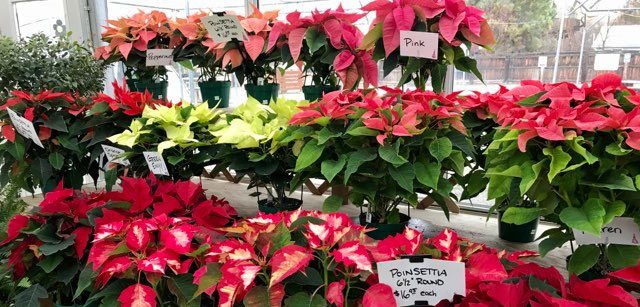Selection
Poinsettias do well in the home and keep their color sometimes until mid-March. The showy red, pink, white, yellow, bicolored or speckled modified “leaves” are called bracts. With proper light and temperature, they accumulate the anthocyanin pigments that give them their color. The flowers (cyathia) of the poinsettia are in the center of the bracts. Male and female parts are present, along with a yellow-edged nectary with sweet, fragrant nectar.
Poinsettias come in many colors and forms. New selections appear every year. Choose a plant with uniformly dark green foliage. However, cultivars with lighter colored or mottled bracts typically have lighter green foliage.
Plants with pale green, yellow or fallen leaves generally have a root disease problem, have been overwatered, had an excessive dry period, or received limited fertilization. Bracts should be well developed with little pollen showing on the flowers.
When outside temperatures approach 35F, be sure the plant is well wrapped or sleeved before transporting. Low temperatures, even for short periods, can damage leaves and bracts. Remove sleeves promptly to prevent epinasty, a downward bending of the petioles, which are the slender stalks that attach the bracts to the stem.
Care Requirements
Poinsettias thrive on indirect, natural daylight — at least six hours a day. Avoid direct sunlight, as this may fade the bract color. If direct sun cannot be avoided, diffuse the light with a shade or sheer curtain. To prolong color, keep plants out of traffic areas and protect from cold drafts and excessive heat. Ideal temperatures are 67F to 70F during the day and 60F to 62F at night. Remove damaged or diseased leaves.
Poinsettias require moderately moist soil. Check plants daily and water thoroughly whenever the soil feels dry to the touch. Plants in clay pots require more water, while those in plastic pots are easily overwatered. Apply water until it runs out the drainage hole. However, do not allow poinsettias to sit in standing water. If the container is wrapped with foil, remove it when watering or make a hole in it for drainage. Discard any collected water in the drainage receptacle.
A poinsettia does not require fertilization while it is in bloom. However, to maintain green foliage and promote new growth indoors after the holidays, apply a balanced all-purpose house plant fertilizer once per month. Always follow the directions on the fertilizer label.
adapted from Colorado State University Extension fact sheet – Poinsettias 7.412 by S.E. Newman, Colorado State University Extension greenhouse crops specialist and professor, horticulture and landscape architecture; and B. A. Edmunds, regional Extension specialist – commercial greenhouses and nurseries. Original author, K.L. Goldsberry, horticulture professor, horticulture and landscape architecture. Reviewed 11/09.

